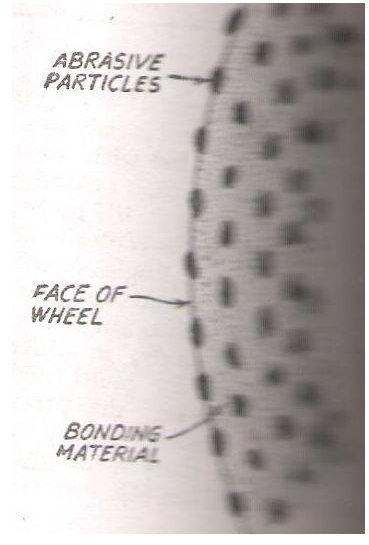Standard abrasives used in industrial grinding processes
Introduction
We took at look at the process of grinding and its usefulness in our previous article. We know from that study that abrasive particles form the heart of the grinding system and are used to remove metal in minute quantities in a fast manner. Now we will proceed to study about the nature of these particles and what sort of stuff they are made up of in the following sections.
Types of Abrasives
As shown in the picture alongside, the wheel consists of embedded abrasive particles which are strongly bonded with appropriate material and serve the purpose of multiple edged cutting tools. The very first property required for abrasive particles is their extreme hardness so that they can cut through any metal however tough and hard to cut. Intuitively, it can be imagined that in order for these materials to cut the work piece they should have more hardness than the work piece, as otherwise the reverse process would happen and the abrasive particles will get cut and the work piece will act like a grinding wheel, which is certainly not an acceptable scenario. These materials also need to be tough so as not to fracture readily under working conditions. Uniformity in composition and purity of these materials are other features which is necessary.
Basically there are two types of materials used in the manufacture of abrasive particles, namely artificial and natural materials.
Natural materials
As the name itself suggests, these refer to the naturally occurring materials in which nature plays a major role in their formation. A few examples of naturally occurring abrasive materials include sand, quartz, emery, garnet, and so forth. These materials are used in several applications but the main problem with them is that there is a lack of direct control over the properties of these materials since they are not man-made. Hence, in most cases they may not be an optimum choice for the job.
Artificial materials:
As mentioned previously, these materials are more suitable for most purposes since they can be custom made for various applications and there is relatively more control over the properties of these materials vis-à-vis natural materials. Some of these materials include Aluminium Oxide, Boron Carbide, Silicon Carbides, and so forth. It will not be possible to discuss each of these materials and their uses in detail, but one of them has been discussed below to give an idea to the reader about it.
Bauxite is fused with ground coke and iron scraps by putting it in a furnace after which it is crushed, washed, and treated appropriately to manufacture Aluminium Oxide. The final powder obtained is red-brown in colour and is used for abrasive material after properly grading them.
Though the abrasive material is very important and performs the actual cutting process, it is equally important to know how the grinding wheel is manufactured without which grinding will not be possible and this will be taken up in the next article.
